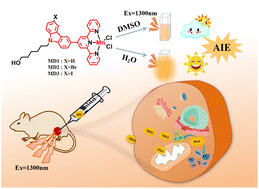Ligand-regulated three-photon AIE properties of manganese(ii) complexes for photodynamic therapy†
Abstract
Owing to the advantages of deeper penetration depth and lower biological damage, multi-photon AIE probes are widely used in the field of multi-photon therapy. We have developed a series of carbazole terpyridine manganese(II) complexes (MD1–MD3) that are promising as aggregation-induced emission (AIE) photosensitizers (PSs). MD1–MD3 exhibit excellent three-photon AIE properties in DMSO/H2O solution. We modulated the AIE properties of the Mn(II) complexes by introducing halogen atoms (Br/I). The three-photon fluorescence intensity of the complexes upon introducing halogen atoms is strong under the conditions of fw = 99% and 60%, respectively. Based on halogen-substituted carbazole ligands, MD3 can be applied as a multi-photon absorption photosensitizer which can produce 1O2 and O2˙−. MD3 damages the mitochondrial morphology, leads to a decrease in mitochondrial membrane potential, and then triggers the apoptosis of cancer cells. Furthermore, MD3 is successfully applied as a photosensitizer in tumor theranostics in vivo. This work provides a new idea for ligand modulation of multiphoton AIE ground state transition metal complexes to make them multiphoton therapeutic agents.

- This article is part of the themed collection: Spotlight Collection: Aggregation induced luminescence of metal complexes


 Please wait while we load your content...
Please wait while we load your content...